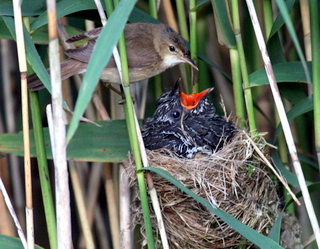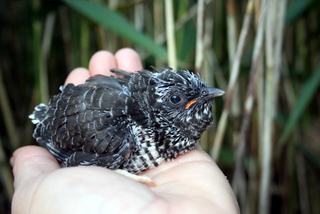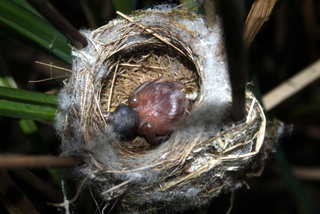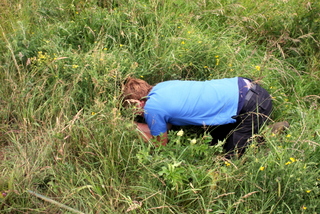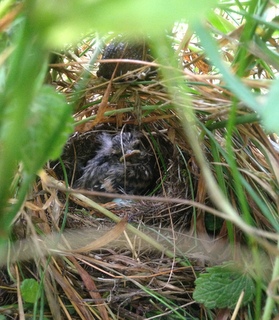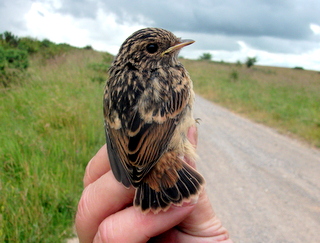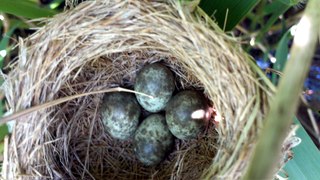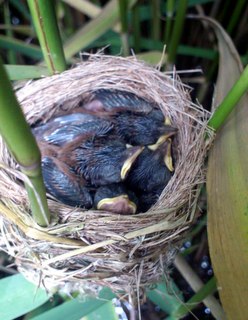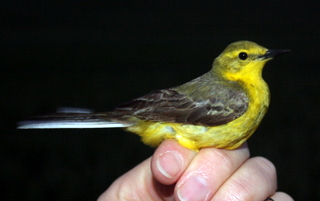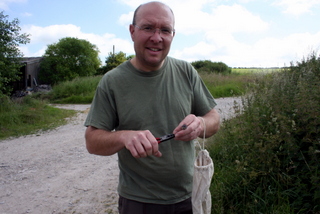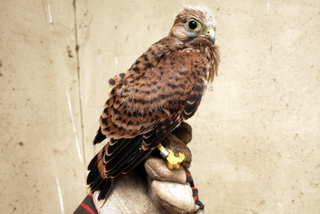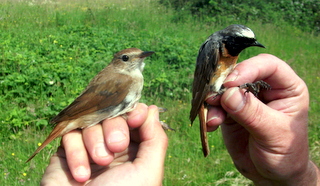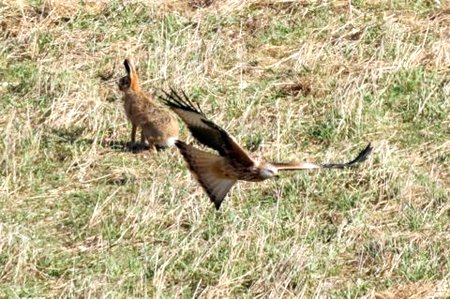SALISBURY PLAIN (CENTRE)
After raining all night in Swindon right up to the point of getting up it was a pleasant suprise to find there had been no rain on our main ringing site.
Nightingale's and Grasshopper Warbler's were singing while we put the nets up and we soon caught 2 Nightingale's, one male we've had several times this season and a new female which brings hope that some breeding might actually be taking place.
The first few net rounds were rather busy with several tit flocks finding the nets and we managed to get well and truly Dunnocked and Robined.
In between net round we managed to expend a lot of energy strimming out a total of twenty-one 60 foot net rides which then set my hay fever going but a good team effort meant that the thigh high grass was gone from all the rides we use on this site.
The morning tailed off quickly after 0900 and with the wind picking up we took the nets down in order to go around the artillery bunkers to ring Swallow pulli. Hightlights of the morning were yet another new Green Woodpecker, the 4th in the last 4 visits, an out of season Reed Warbler and a rather nice male Redstart.
In all 103 new, 37 retraps. GD/PD/OF
Green Woodpecker 1, Swallow 26 pulli, Wren 2(2), Dunnock 10(3), Robin 8, Nightingale 1(1), Redstart 1, Blackbird (1), Reed Warbler 1, Lesser Whitethroat (1), Whitethroat 7(9), Garden Warbler 2(5), Blackcap 6(2), Chiffchaff 1(3), Willow Warbler 4(4), Long Tailed Tit 12(1), Blue Tit 5, Great Tit 14(1), Bullfinch (4), Tree Sparrow 2 pulli
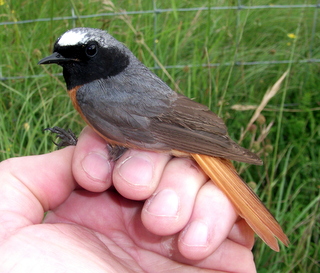
SWINDON STW CES SESSION 5
We met up at 04:15 with the vegetation saturated by the overnight thunder, lightning and torrential rain. We put up a few extra nets to cover a corner of the site away from the CES area and this was not bad at all with a family party of Lesser Whitethroats in it. We added Kingfisher to the CES totals today and it shows what a great day we had when Kingfisher doesn’t warrant a photo. It was nice to see plenty of young warblers and great to see all of the young Dunnocks because as a resident bird they will form a cornerstone of the CES data that we will produce in the long run.
Cuckoos were still very evident but we have yet to find a Cuckoo egg on a Reed Warbler nest on site. We ringed two broods of Reed Warblers. Since my email post about the nests that Simon hasn’t found he has spent most of the time skulking or is that sulking in the reed beds and bushes and last week he came up trumps by finding the holy grail of nests in the guise of a Grasshopper Warbler nest with 6 eggs, they hatched a few days ago and we ringed them today which was an absolute treat. We are delighted to have completed our monitoring of this family with both adults ringed in CES, a successful nest record and 6 nestlings ringed – all pretty amazing when you consider that there are normally 5-8 nest records of this species in the UK each year. Well done Simon!
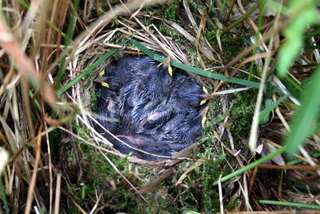
Paul, Biff and I then went on a 6 hour nesting safari across the downs seeing all the farmland classics including Grey Partridge, Corn Bunting, Yellow Wagtail, Tree Sparrow, Yellowhammer and Linnet. We ringed a few broods of Tree Sparrows that completed first broods with 480 ringed to date. Second brood Tree Sparrows are well underway and we are monitoring 90 nests already. A few of the Barn Owls were not ready for ringing but we still ringed 7 Barn Owl nestlings at a fantastic farm where the farm staff are absolutely terrific, it was good fun being raised up to high boxes in the man basket of a JCB. The highlight of the afternoon was ringing the two Buzzards from a nest high on the downs, this was a new species nest record for us.
This was Biffs first nestling safari and he had an absolute blinder, what other 13 year olds get the chance to experience all of the above? But also, how many other 13 year olds could last the pace and still be wide eyed and interested at the end – good lad, and that is why I have agreed to take him on as an official trainee, welcome aboard young man. MP, PA, SW, AM
Reed Warbler 6 (9), Sedge Warbler 4 (1), Blackcap 14, Whitethroat 2 (1), Lesser Whitethroat 4 (1), Chiffchaff 3 (2), Dunnock 16 (2), Robin 3, Blackbird 3 (3), Wren 1 (1), Great Tit 3, Blue Tit 10 (2), Greenfinch 8 (1), Bullfinch 3 (3), Goldfinch 2 (1), Kingfisher 1, Song Thrush 0 (1)
Nestlings: Grasshopper Warbler 6, Tree Sparrow 22, Barn Owl 7, Buzzard 2, Reed Warbler 8
The totals of 83 mist netted plus 45 nestlings makes for a pretty impressive 128 ringed and 28 retrapped. CES total was an excellent 72 new and 19 retraps.



